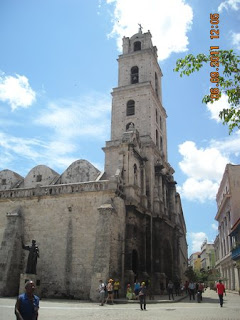New updates as my travels took me far and wide. Recently, I visited Mexico, Cuba and Belize. Photos below of my journeys there; now, my explorations take me to property in Chetumal, QR, MX, or, across the border in Corazol Town, BZ. Adjacent to the sea, both offer all the basic amenities I need. And, the daily costs substantially lower than the U.S. Healthcare provided by US trained doctors, nurses and dentists at one tenth the cost. And, in a few weeks, my continued journeys in Chetumal / Corazol Town continue.
Beautiful Cathedral above my hotel
Sunset at the Chateau Miramar on the Caribbean Sea
Miramar Cathedral and former Convent, Still Open and Starkly Beautiful
Balcony View of Coast, Chateau Miramar on the far left
Plaza de La Cathedra
National Capitol Building
Bacardi Building - an Art Deco Delight
Florditia Restaurant and Bar - a Hemingway Favorite
St Francis de Asisi Cathedral and Plaza
Hemingway Home, Now a Museum
Onions and Garlic - Vinellas Valley
Enrst Hemingway's Famous Bar - Great Mojitos!
Museum of Fine Arts
Plaza Vieja
Black Orchid Resort, on Belize River
Howling Monkeys Outside my Bedroom
Black Iguana Along the Riverside
Belize River Teeming with Fish and Small Crocodiles -- No Swimming!
Lessons learned from traveling to, within and from Cuba. Despite more open borders, travel by U.S. citizens requires careful planning, advanced reservations, and a clear sense of how you'll travel throughout the country. First, U.S. based credit cards are not accepted by anyone once you've entered the country. Only cash or a non-U.S. credit card are acceptable. Change your U.S. dollars to Mexican pesos; I did that as I passed through Cancun to La Habana. Once in Cuba, go to a bank, and convert Mexican pesos to Cuban tourist pesos, called CUC (pronounced "cuke"). Standard Cuban pesos, used by the local citizenry, cannot be used by tourists. The exchange rate of U.S. dollars to Cuban CUCs is very unfavorable. Converting to Mexican pesos eases this pain.
A typical fifteen minute taxi ride from the outskirts of La Habana to Old Town, about ten miles, will cost 15 Cuban CUCs with a 1-2 CUC tip. Standard fare for lunch or dinner, including drinks, will cost 25 CUCs per person. Major museums charge 10 CUCs; smaller ones look for a 1-2 CUC donation.
Downtown, or Old Town, La Habana continues to improve. Plazas are being restored, storefronts are opening, restaurants and bars abound, and grifters and beggars also exist. Toilets come with attendants who expect a tip for toilet paper (bring your own). However, the back alleys of Old Town still teem with the old ways -- children playing in the streets, families hawking all kinds of trinkets, dogs asleep in the gutter, endless stream of bicycles, motorbikes and automobiles.
Due to the humid climate, and particularly along the coast, there is the constant presence of mold. Not all molds are bad, however, if your sensitivity to mold allergens is high, beware of its presence. Hotels, public spaces and restaurants make every effort to eliminate the mold. Backstreet cafes and bars are less prone to do so.
Unleaded gas may exist, however, the pollution from automobiles can be overwhelming. No catalytic converters or other smog control devices exist. Just big clouds and plumes of exhaust at every intersection. Obviously dine at restaurants and bars away from main avenues and intersections.
People are generally friendly; some speak English, most do not. Rudimentary Spanish will get you around town fairly easily. Buses are very crowded, and do not adhere to schedules. To visit out of the way places, for example, Ernest Hemingway's beautiful home, took forty-five minutes. The taxi driver waited for us while we roamed the grounds, museum and gift shop; then took us back to the hotel: total cost of 60 CUCs for two of us.
When you travel away from La Habana, the real poverty becomes apparent. By law, each farmer is granted ten hectares of land on which to farm and raise animals. However, very little of the land is arable, and water is scarce. Cuba has put in over two hundred dams to create a vast network of lakes. However, water is a very precious commodity. On the bus trip to the Vinellas Valley, we saw acres and acres of sugar cane and tobacco. Occasionally, we saw small family gardens, but that was a rarity. Life is simple and harsh in Cuba, yet, the people are generally happy. Music is everywhere; it is their antidote to the starkness of their reality.
There are no magazines or newspapers as you would find in any metropolitan center throughout the world. There is a national newspaper, in English and Spanish. Television covers politics and world events, however, shaded through a communist / socialist lens. Lots of coverage of Venezuelan, Nicaraguan, Vietnam, Chinese and Russian political activities. Endless music videos blasting our "bubble gum" music. And, of course, sports including soccer (or futbol), cricket, baseball (Cuba's version of the amateur World Series was being played during my visit) and rugby. No US or European TV channels were broadcast. And, of course, everywhere there were posters and painted slogans promoting or remembering Fidel Castro, Che Guevara and the 1959 Revolution.

























No comments:
Post a Comment